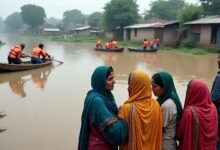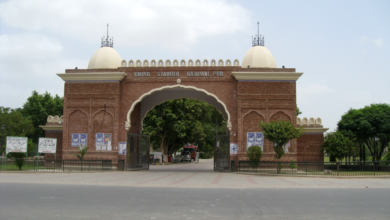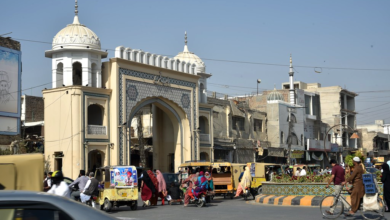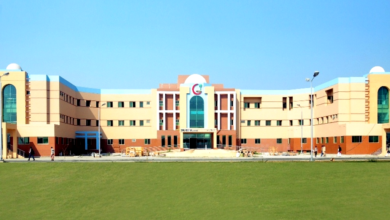
Rebuilding Hope: Addressing the Impact of Sutlej River Floods in South Punjab
South Punjab battles the worst Sutlej River floods in history. Over 2 million affected, massive relief operations underway. Latest updates on flood impact, rescue efforts.
The devastating Sutlej River floods of 2025 have marked a watershed moment in Pakistan’s disaster management history, fundamentally transforming the landscape of South Punjab and testing the resilience of millions of residents. What began as an intense monsoon season quickly escalated into what officials are calling the worst floods in Punjab’s history, affecting over 2 million people and displacing hundreds of thousands across the region.
This unprecedented natural disaster, triggered by record-breaking rainfall and cross-border water releases from Indian dams, has exposed both the vulnerabilities and strengths of Pakistan’s disaster response system. As floodwaters from the Sutlej, Chenab, and Ravi rivers continue to reshape communities across South Punjab, the focus has shifted from immediate rescue operations to comprehensive rehabilitation efforts aimed at rebuilding hope and restoring livelihoods. The scope of destruction encompasses over 4,400 villages, with agricultural losses threatening food security and economic stability across the region.
Understanding the Scale of the 2025 South Punjab Floods
The Perfect Storm: Multiple Factors Converge
The 2025 Punjab floods represent a complex disaster stemming from multiple converging factors that created an unprecedented crisis. Heavy monsoon rains in the upper catchment areas, particularly in Himachal Pradesh and Jammu & Kashmir, combined with surplus water releases from major dams including Pong, Ranjit Sagar, and Bhakra, intensified flooding in downstream districts of Pakistan.
Climate change has emerged as a significant contributor to the severity of these floods. Rising temperatures have increased the moisture-holding capacity of air masses, creating conditions for sudden, intense downpours. The Pakistan Meteorological Department reported that some areas received nearly three times their normal rainfall between June and August 2025.
Cross-border water management issues have added another layer of complexity to the disaster. Following Pakistan’s withdrawal from the Indus Waters Treaty in April 2025, coordination between India and Pakistan on water releases became more challenging, though diplomatic channels were eventually used to share critical flood warnings.
Geographic Impact and Affected Districts
The floods have devastated multiple districts across South Punjab, with some areas experiencing their highest water levels in 35 years. The most severely affected regions include:
- Multan District: Over 100,000 people evacuated in three days, with Jalalpur Pirwala tehsil becoming a focal point for rescue operations
- Kasur and Narowal: Border districts facing dual challenges from local rainfall and cross-border water flows
- Bahawalnagar: 105 villages affected with 150,000 people impacted and 90,000 residents displaced
- Muzaffargarh and Rahim Yar Khan: Critical areas where rising river levels pose ongoing threats to urban centers
The Sutlej River at Ganda Singh Wala reached exceptionally high flows of over 261,000 cusecs, while the Chenab River recorded dangerous levels exceeding 859,000 cusecs at key barrages. These unprecedented water levels have created a cascading effect downstream, with flood warnings extending into Sindh province.
Government Response and Disaster Management Efforts
National Disaster Management Authority’s Coordinated Response
The National Disaster Management Authority (NDMA) has implemented its most comprehensive disaster response operation to date, coordinating efforts across multiple provinces and federal agencies. The authority’s app-based early warning system enabled over 259 swift rescues and facilitated the safe evacuation of more than 174,000 people to higher ground.
Prime Minister Shehbaz Sharif has personally monitored the flood situation, chairing multiple emergency meetings and directing the acceleration of rescue operations across affected districts. The federal government’s response has emphasized zero-casualty evacuations, a significant improvement from previous disasters that demonstrates enhanced disaster preparedness.
Key components of the government response include:
- Deployment of Pakistan Armed Forces for mass evacuations and supply distribution
- Establishment of over 404 relief camps with adequate facilities for displaced families
- Creation of 488 medical camps providing healthcare services to affected populations
- Setup of 421 veterinary camps treating livestock in flood-hit areas
- Coordination with provincial governments for seamless relief operations
Provincial Relief Initiatives in Punjab
Punjab Chief Minister Maryam Nawaz Sharif has ordered comprehensive rescue operations deploying army units across seven critical districts: Lahore, Narowal, Kasur, Sialkot, Okara, Faisalabad, and Sargodha. The provincial government has implemented innovative approaches to reach stranded populations, including:
Drone-based relief delivery: Punjab Civil Defence has utilized Home Department drones to deliver food and medicine to stranded people in remote flood-affected areas, ensuring that even isolated communities receive essential supplies.
Boat rescue operations: Over 12,427 people were rescued by boat across Punjab in a single 24-hour period, demonstrating the scale and efficiency of water-based rescue efforts.
Helicopter evacuations: Air support has been crucial for reaching areas where road access has been completely cut off by floodwaters.
Humanitarian Crisis and Community Impact
Human Displacement and Shelter Challenges
The humanitarian impact of the Sutlej River floods extends far beyond immediate displacement, creating complex challenges that will require sustained attention. Over 1.2 million people have been displaced according to recent estimates, with many families losing not just their homes but their entire livelihoods.
Relief camps across South Punjab are housing thousands of displaced families, with particular attention being paid to vulnerable populations including pregnant women, children, and elderly residents. The case of Shumaila Riaz, a 19-year-old pregnant woman spending four days in a relief camp while experiencing pregnancy complications, illustrates the human dimension of this crisis.
The displacement has created several critical challenges:
- Overcrowding in relief facilities despite doubling the number of camps
- Privacy and sanitation concerns, particularly affecting women and families
- Educational disruption with school closures affecting critical examination periods
- Psychological trauma from sudden loss of homes and community connections
Agricultural Devastation and Food Security Concerns
The agricultural impact of the floods threatens both immediate food security and long-term economic stability across South Punjab. Over 1 million acres of cropland have been inundated, destroying standing crops and threatening the livelihoods of hundreds of thousands of farming families.
Cotton crops face losses estimated between 20-30%, representing millions of dollars in economic damage to one of Pakistan’s key export commodities. The timing of the floods, coinciding with the critical growing season, has maximized agricultural damage and created concerns about food price inflation in the coming months.
Livestock losses have been equally devastating, with over 100,000 animals perishing in the floods. The relocation of 1.581 million animals to safe locations represents one of the largest livestock rescue operations in Pakistan’s history, highlighting the comprehensive nature of the disaster’s impact on rural communities.
International Support and Cross-Border Cooperation
Global Humanitarian Response
The international community has responded to Pakistan’s flood crisis with both financial assistance and technical support, recognizing the global implications of climate-related disasters in vulnerable regions. The United Kingdom pledged £3.4 million for humanitarian preparedness, while China announced a $6 million grant specifically for home reconstruction efforts.
The United Nations released $600,000 in emergency funds, and the International Federation of Red Cross and Red Crescent Societies launched a CHF 17 million appeal in partnership with the Pakistan Red Crescent Society. These contributions, while significant, represent only a fraction of the estimated $6-10 billion in economic losses caused by the floods.
Turkish Cooperation and Coordination Agency (Tika) has intensified relief operations across multiple districts in Punjab, delivering essential supplies including drinking water, medical aid, and food rations to affected communities.
Regional Water Management Challenges
The cross-border nature of the river systems has highlighted the critical importance of regional cooperation in flood management. Despite the suspension of the Indus Waters Treaty, India provided flood warnings to Pakistan through diplomatic channels, demonstrating that humanitarian concerns can transcend political tensions.
However, the floods have also exposed the vulnerabilities created by uncoordinated water releases from upstream dams. Pakistani officials have called for enhanced mechanisms for sharing hydrological data and coordinating dam operations to prevent future downstream disasters.
Climate Change and Long-term Implications
The Role of Global Warming in Extreme Weather Events
Climate scientists have identified clear links between the intensity of the 2025 Punjab floods and broader climate change patterns affecting South Asia. The Intergovernmental Panel on Climate Change (IPCC) has previously warned that heavy precipitation events are increasing in frequency and intensity across the region, with high confidence in this trend continuing.
Dr. Syed Faisal Saeed, Pakistan’s chief meteorologist, has warned that “monsoon rains are likely to increase in the coming decades,” indicating that the 2025 floods may not be an isolated incident but rather a preview of Pakistan’s climate future.
The warmer air masses associated with climate change can hold significantly more moisture, creating ideal conditions for the type of sudden, intense downpours that triggered the current disaster. This phenomenon, combined with glacial melting in the upper catchments, has created a new paradigm for flood risk management in the region.
Building Climate Resilience
The 2025 floods have accelerated discussions about climate adaptation strategies for Pakistan’s river systems and vulnerable communities. Key areas for improvement include:
Early warning systems: While the NDMA’s app-based alerts proved effective, expanding coverage and improving communication with rural communities remains a priority.
Infrastructure resilience: Aging irrigation infrastructure and inadequate drainage systems have amplified flood impacts, highlighting the need for climate-resilient infrastructure investments.
Community preparedness: Bangladesh’s success with community-led adaptations like elevated homes and floating gardens, which have reduced flood damages by 40%, offers a model for Pakistani communities.
Ecosystem restoration: Deforestation and wetland destruction have reduced natural flood buffers, making ecosystem restoration a critical component of long-term resilience building.
Technology and Innovation in Flood Response
Digital Solutions for Disaster Management
The 2025 flood response has showcased both the potential and limitations of technology in disaster management. Drone technology has proven invaluable for both damage assessment and supply delivery, allowing responders to reach areas that would otherwise be inaccessible.
Satellite monitoring and real-time hydrological data have enabled more accurate flood forecasting, though gaps in data sharing between countries have limited the effectiveness of cross-border flood prediction.
Mobile technology has transformed communication during the crisis, with the NDMA’s mobile alerts reaching hundreds of thousands of people and enabling rapid coordination of rescue efforts.
Lessons from International Best Practices
Netherlands’ flood management expertise and Japan’s early warning systems offer models that Pakistan could adapt to its unique geographical and climatic conditions. The integration of artificial intelligence in flood prediction and blockchain technology for transparent aid distribution represent emerging opportunities for enhancing disaster response capabilities.
Economic Recovery and Reconstruction Strategies
Immediate Economic Impacts
The economic devastation caused by the Sutlej River floods extends across multiple sectors, with preliminary estimates suggesting total losses between $6-10 billion. This figure encompasses not only direct damage to infrastructure and agriculture but also the broader economic disruption caused by displaced populations and interrupted supply chains.
Small businesses in affected areas have been particularly hard hit, with many losing inventory, equipment, and customer bases simultaneously. The informal economy, which employs millions of people across South Punjab, faces particular challenges in recovery due to limited access to formal financial services and insurance coverage.
Reconstruction Planning and Sustainable Development
“Build back better” principles are being incorporated into reconstruction planning, with emphasis on climate-resilient infrastructure and sustainable development practices. The Punjab government has announced comprehensive damage assessment programs that will inform targeted reconstruction efforts.
Microfinance institutions and development banks are preparing specialized programs to support small business recovery and agricultural rehabilitation. Crop insurance mechanisms are being strengthened to provide better protection for farmers against future climate-related losses.
Community Resilience and Social Cohesion
Grassroots Response and Volunteerism
The flood response has demonstrated remarkable community resilience and social solidarity across South Punjab. Local volunteers have played crucial roles in rescue operations, often reaching stranded families before official rescue teams could arrive.
Religious institutions and community organizations have provided essential services including temporary shelter, food distribution, and emotional support for displaced families. The Sikh community’s gurdwaras have opened their doors to flood victims regardless of religious affiliation, exemplifying the inclusive spirit of disaster response.
Women’s groups have organized specialized support for female flood victims, addressing specific needs around privacy, safety, and healthcare that might otherwise be overlooked in emergency response efforts.
Mental Health and Psychosocial Support
The psychological impact of the floods requires sustained attention beyond the immediate rescue phase. Trauma counseling services are being established in relief camps, with particular focus on children who have experienced displacement and loss of familiar environments.
Community-based psychosocial support programs are being developed to help affected populations process their experiences and develop coping strategies for the long road to recovery ahead.
Looking Forward: Lessons Learned and Future Preparedness
Policy Recommendations for Enhanced Preparedness
The 2025 Sutlej River floods have generated important lessons for Pakistan’s disaster management framework. Key policy recommendations emerging from this experience include:
Regional cooperation mechanisms: Establishing formal protocols for sharing hydrological data and coordinating water releases across international boundaries, even during periods of political tension.
Infrastructure investment: Prioritizing climate-resilient infrastructure development, including flood-resistant housing, improved drainage systems, and strengthened river embankments.
Early warning systems: Expanding coverage and improving communication strategies to ensure that vulnerable communities receive timely and actionable flood warnings.
Community preparedness: Implementing comprehensive disaster risk reduction training at the community level, with particular emphasis on vulnerable populations and remote areas.
Innovation and Technology Integration
Artificial intelligence and machine learning applications for flood prediction and resource allocation represent promising areas for enhancing Pakistan’s disaster response capabilities. Blockchain technology could improve transparency and efficiency in aid distribution, while Internet of Things (IoT) sensors could provide real-time monitoring of water levels and infrastructure conditions.
Public-private partnerships will be essential for implementing these technological solutions at scale, requiring new frameworks for collaboration between government agencies, technology companies, and international development organizations.
The 2025 Sutlej River floods in South Punjab represent both a humanitarian crisis and an opportunity for transformation. While the immediate focus remains on rescue, relief, and recovery, the longer-term challenge lies in building a more resilient Pakistan that can withstand the increasing frequency and intensity of climate-related disasters. Through enhanced regional cooperation, innovative technology adoption, and community-centered approaches to resilience building, Pakistan can emerge from this crisis stronger and better prepared for future challenges. The response to these floods has demonstrated both the vulnerability of communities to climate change and their remarkable capacity for resilience when supported by effective disaster management systems and international solidarity.







